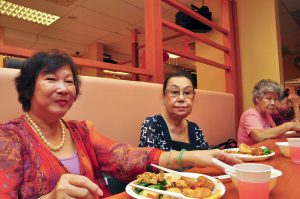Undernourishment a problem among elderly
A worrying statistic puts some elderly at risk of ill health from lack of nutrition.
BY: Elizabeth Law
 Elderly malnutrition is prone to affect one in three, says survey of 421 people on dietary habits. According to a nutritional survey commissioned by Abbott Nutrition, almost three in 10 respondents were found to be in moderate to high risk of malnutrition, which could lead to falls, fractures and infections.
Elderly malnutrition is prone to affect one in three, says survey of 421 people on dietary habits. According to a nutritional survey commissioned by Abbott Nutrition, almost three in 10 respondents were found to be in moderate to high risk of malnutrition, which could lead to falls, fractures and infections.
Not a balanced diet
It also found that only one percent of those over 50 have a balanced diet that meets the Health Promotion Board (HPB) recommendations. Each day, on average, an older Singaporean has 3.78 servings of rice and other carbohydrates, instead of the recommended five to seven servings, the survey found. He eats 1.78 servings of meat and dairy products, instead of two to three servings. And he consumes 0.85 serving of fruit and 1.22 servings of vegetables, instead of two servings each.
Founder and vice-president of the Society for Geriatric Medicine, Dr Chan Kin Ming, also consultant of the survey, said that while some elderly may be seemingly healthy, research has shown that there is a lack in ample nutrition. “It is critical that the elderly eat complete and balanced diets (based on HPB’s Healthy Diet Pyramid) to ensure they do not develop marginal nutritional deficiencies, which over time make them prone to frailty, falls, infections, depression, symptoms of pain, muscle loss and poor wound healing.”
He said some elderly people believe in not eating too much as their digestive systems have deteriorated; others have trouble chewing or swallowing, or are deterred by the cost of food. Nutritionists and dieticians point to cost savings, which can lead to only one meal per day, denture problems, not wanting to eat alone or the inclination to not prepare meals for one as other possible reasons for elderly malnutrition. This is supported by the survey findings, which showed that elderly with the highest risk lived alone in one- or two-bedroom HDB flats.
Some solutions
Dr Chan shared tips on how to combat an elderly’s lack of interest in food and his recommendations for a senior who complains of poor digestion. To combat the lack of interest in food, he advised the elderly and their caregivers to alter the food texture (e.g. minced meals and pureed food can be prepared using a blender or food processor) so that it is more palatable. Eating such food minimises chewing while allowing the elderly to maintain an adequate food and nutrient intake. For a senior who complains of poor digestion, Dr Chan recommends five smaller meals be eaten throughout the day to avoid overloading the stomach, instead of the three main ones of breakfast, lunch and dinner.
BMI not that reliable
The survey also revealed that Body Mass Index (BMI) is not a reliable way to measure nutrition because it only measures body mass at a superficial level. Elderly can present with a healthy BMI yet still be malnourished. Said Dr Chan: “It is important to use more sensitive and in-depth nutritional screening tools to accurately determine if an older individual is malnourished, over-nourished or healthy.”
General practitioners will also be stepping up in screening for malnourished elderly patients though the use of the “Determine Your Nutritional Health checklist”, developed by the American Academy of Family Physicians, American Dietetic Association and the National Council of Aging in the United States.
However, not all are optimistic that a simple checklist will be effective in screening for malnutrition. Social work practitioner Mabel Kong says that the older patients do not usually tell doctors the whole truth. It might also be too late since seniors only visit the doctor when they are feeling unwell, possibly a result of nutrient loss.
“Perhaps what would be better if family members, or people who constantly visit these individuals ask about their food intake. This way, those who are familiar with their lifestyle can sound the alarm bell early.”
** Use the checklist here to find out if you or someone is at nutritional risk.
(PICTURE ABOVE: Courtesy of Elizabeth Law)

0 Comments